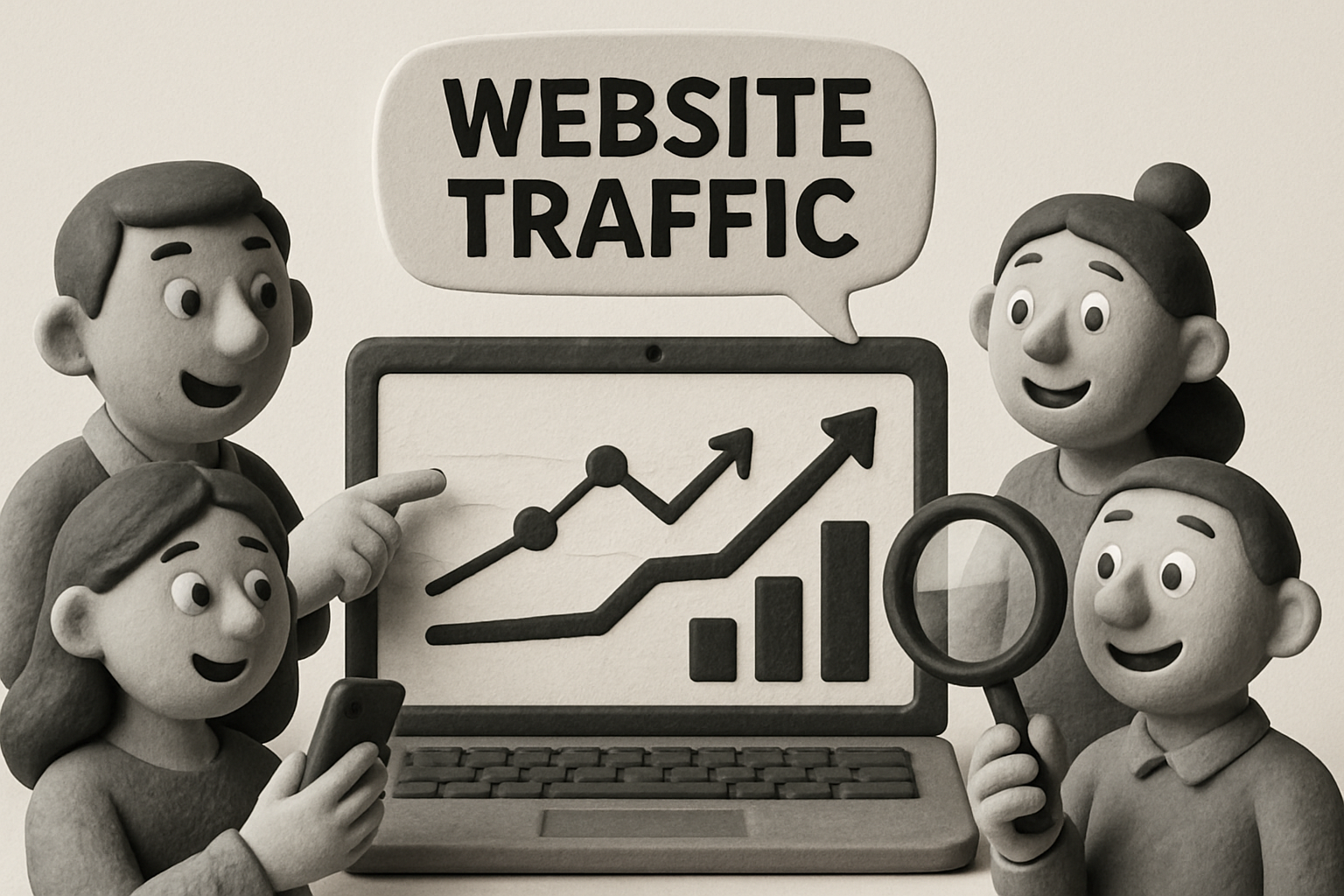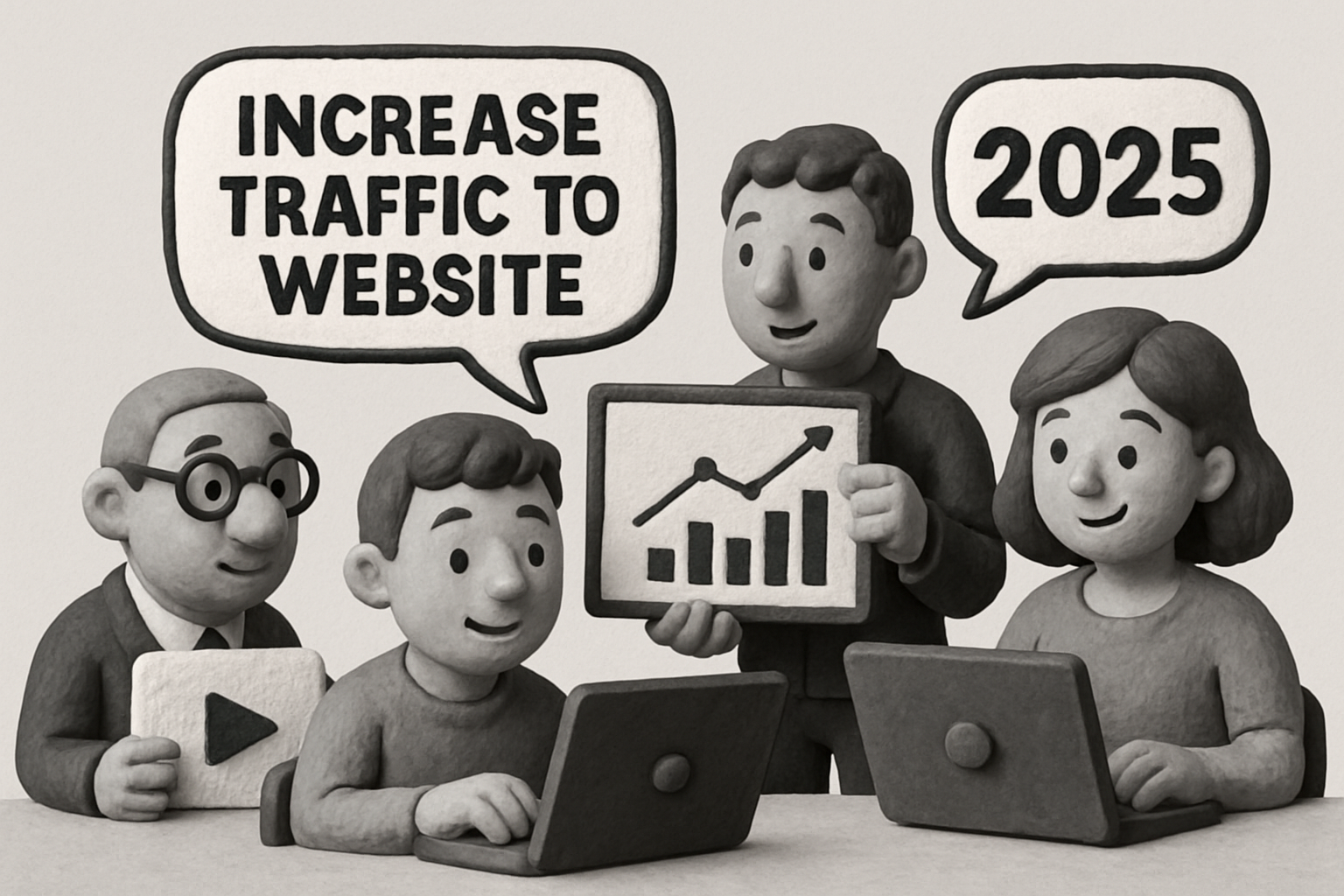Imagine being able to increase traffic to website in 2025—without doubling your marketing budget. For 61% of marketers, website traffic remains the top digital challenge. Yet, with only 22% of visitors arriving via direct URL, relying on a single method simply won’t cut it.
This article uncovers the 12 best, proven ways to boost your website’s visibility using cutting-edge SEO, content, social media, and outreach strategies. Ready to outperform your competitors and turn visitors into loyal customers? Read on for actionable insights and the most effective tactics for the year ahead.
Why Website Traffic Matters in 2025
Ever feel like the digital marketplace is getting more crowded every year? You’re not imagining things—competition online is fiercer than ever, and the need to increase traffic to website assets has become a make-or-break factor for modern businesses. In 2025, simply having a website isn’t enough. Your online success depends on standing out in a sea of competitors and capturing attention where your audience spends their time.

The Evolving Digital Landscape
The digital world is transforming rapidly. Businesses now face a landscape where mobile and voice search dominate, with more users interacting through smart devices than ever before. Google’s algorithms have also evolved, rewarding sites that deliver high-quality, relevant content and penalizing those that don’t adapt.
According to Website statistics 2025, 33% of all website traffic comes from organic search, and a staggering 71% of clicks go to first-page results. This means your ability to increase traffic to website pages directly impacts brand visibility and revenue.
What’s driving this change? AI and automation are making marketing more efficient, but also more competitive. Companies that leverage these tools to refine their strategies are scaling faster than those stuck in old habits. For example, brands updating their SEO and content strategies with AI insights often see exponential growth in visitors.
Key Challenges Businesses Face
While the opportunities are immense, so are the challenges. The race to increase traffic to website content is complicated by rising competition and content saturation. Every niche is crowded with blogs, videos, and ads vying for clicks.
Keeping up with changing SEO rules is a constant battle. What worked last year might not work tomorrow. Search engines now focus on user intent, mobile experience, and site speed, making it essential to adapt strategies for 2025. If you don’t evolve, your online presence risks stagnation or decline.
Rapid digital shifts mean businesses must stay agile. Monitoring trends, testing new tactics, and learning from industry leaders are now part of day-to-day survival. Those who fail to pivot quickly risk falling behind, losing both traffic and market share.
Benefits of Increasing Website Traffic
Why should you care about your numbers? When you increase traffic to website landing pages and blog posts, you open doors to more leads, sales, and loyal fans. More visitors mean more opportunities to convert, build brand authority, and foster trust in your niche.
Higher website traffic also provides a wealth of data for optimization—allowing you to fine-tune campaigns, improve conversion rates, and make smarter growth decisions. The payoff? Sustainable business growth and a stronger online reputation.
In 2025, consistently working to increase traffic to website properties isn’t just about numbers—it’s about building a resilient, future-ready business equipped to thrive in a hyper-connected world.
The 12 Best Ways to Increase Traffic to Website in 2025
Ready to unlock the most effective strategies to increase traffic to website in 2025? From AI-driven SEO tweaks to content marketing hacks and social media mastery, these 12 proven methods will help you stand out in a crowded digital landscape. For a deeper dive into how these tactics work together, check out these Proven SEO and traffic tips to further supercharge your growth.

1. Optimize for Voice and Visual Search
Voice assistants like Siri, Alexa, and Google Assistant are changing the way people search online. Over 50% of searches now happen through voice, while visual search tools like Google Lens and Pinterest Lens are growing 30% year-over-year.
To increase traffic to website, update your content for conversational keywords and structure answers for featured snippets. Use descriptive alt text on images for better visual search compatibility. For example, a retailer optimized product images and saw a 20% boost in traffic.
Don’t forget to refresh older content so it’s compatible with voice and visual search trends. Optimizing for these search types ensures your website meets users where they are, making it easier for them to find you.
2. Publish High-Quality, Evergreen Content
Evergreen content is material that remains relevant long after it’s published. Think how-to guides, tutorials, or resource lists—content that solves persistent problems and matches user intent.
Businesses that blog regularly see up to 55% more website visitors. To increase traffic to website, focus on long-form content (2000+ words) and update your evergreen posts regularly to keep rankings high.
Regular updates ensure your content stays accurate and competitive, driving consistent, compounding traffic over time. Prioritize quality and depth to build trust and authority in your niche.
3. Leverage Long-Tail Keyword Strategies
Long-tail keywords are longer, more specific search phrases—like “best eco-friendly running shoes for women 2025” instead of just “running shoes.” These keywords have lower competition and higher conversion rates.
Use tools like Ahrefs, SEMrush, or Google Keyword Planner to discover untapped opportunities. Incorporate long-tail variations naturally in your content and metadata to increase traffic to website.
Targeting long-tail keywords makes it easier to rank in search results, bringing in visitors who are more likely to convert. Consistent use across your site can lead to sustainable, targeted growth.
4. Enhance On-Page SEO and SERP Appearance
On-page SEO is all about optimizing your website’s elements—title tags, meta descriptions, headings, and internal links—for maximum search visibility. Write compelling title tags (under 55 characters) and meta descriptions (under 145 characters) with your target keyword.
Compress images and use descriptive alt text to improve load speed and accessibility. Adding schema markup can help your content appear as featured snippets, boosting click-through rates and helping increase traffic to website.
Regularly audit your pages with tools like Google Search Console or Yoast SEO to keep your on-page SEO sharp and effective.
5. Build Authoritative Backlinks
Backlinks from reputable, relevant sites are still one of Google’s top ranking factors. To increase traffic to website, focus on earning links through guest posting, expert roundups, digital PR, and resource link building.
Websites with strong backlink profiles can see up to 3x more organic traffic. For example, landing a mention on a niche industry blog can drive both authority and referral visits.
Avoid spammy link schemes, which can result in penalties. Instead, prioritize building genuine relationships with other site owners for sustainable growth.
6. Maximize Internal Linking Structure
Internal linking connects your pages and guides visitors through your website. A logical link structure helps both users and search engines discover your most important content.
Link from high-authority pages to your key conversion pages to increase traffic to website and distribute PageRank. Add breadcrumbs and contextual links to keep visitors engaged longer.
Regularly audit your site for orphan pages—those without internal links—and update your structure to ensure every valuable page is easily found and indexed.
7. Create Engaging Visual and Video Content
Visual and video content significantly boost engagement and dwell time. Embedding videos in your blog posts, sharing infographics, and posting visual content on social media can increase organic traffic by up to 157%.
Optimize images and videos with descriptive file names, alt text, and transcripts. A SaaS company, for example, saw a 30% increase in backlinks after launching branded infographics, which helped increase traffic to website.
Use tools like Canva, Lumen5, and YouTube SEO best practices to make your visuals stand out and drive more visitors.
8. Boost Organic Social Media Engagement
Being present and active on platforms like Instagram, LinkedIn, TikTok, and X (Twitter) is key. Consistent, authentic engagement—sharing value-driven content, leveraging trends, and using features like polls and reels—can increase traffic to website from social channels.
Collaborate with influencers, run contests, and encourage user-generated content to expand your reach. For example, a DTC brand doubled referral traffic by partnering with micro-influencers.
Social media remains a powerful tool for building brand awareness and driving new visitors to your site.
9. Invest in Paid Advertising Campaigns
Paid ads offer a fast track to visibility. Platforms like Google Ads, Facebook/Instagram Ads, and LinkedIn Ads allow you to target specific audiences using remarketing, lookalike audiences, and demographic filters.
Set clear campaign goals, test different creatives, and optimize landing pages for conversions to increase traffic to website efficiently. When organic growth is slow, paid campaigns can deliver immediate results.
Ecommerce stores often achieve a high ROI by combining Google Shopping campaigns with Facebook retargeting, ensuring a steady stream of potential customers.
10. Utilize Email Marketing and Newsletters
Email marketing remains one of the most effective ways to nurture leads and bring visitors back. Build segmented lists, personalize your messages, and automate campaigns to increase traffic to website over time.
Send regular newsletters promoting new content, exclusive deals, or useful resources. A B2B company, for example, boosted blog traffic by 40% after launching a biweekly newsletter.
Email delivers one of the highest ROIs among digital channels—don’t overlook its power for driving consistent, repeat visits.
11. List Your Site on Relevant Directories and Platforms
Getting listed on high-authority directories like Google Business Profile, Yelp, and industry-specific sites increases your visibility. These listings help increase traffic to website through local SEO, referral clicks, and trust-building.
Optimize your profiles with accurate information, images, and encourage satisfied customers to leave positive reviews. A service business saw a 25% jump in inquiries after updating its directory profiles.
Directory listings are a foundational tactic for both local and niche website traffic.
12. Regularly Update and Repurpose Existing Content
Refreshing old blog posts ensures your site remains relevant and competitive. Update stats, add new insights, and optimize for new keywords to increase traffic to website.
Repurpose articles into videos, infographics, or social media posts to reach different audiences without starting from scratch. Repurposed content often generates 30% more traffic with less effort than creating new material.
Consistent updates and repurposing are key strategies for long-term, sustainable traffic growth.
How to Measure and Optimize Your Website Traffic Growth
Understanding how to measure and optimize your efforts is essential if you want to systematically increase traffic to website. Without clear tracking, it’s easy to miss growth opportunities or waste resources on what isn’t working.

Setting Up Analytics and Tracking
To effectively increase traffic to website, begin by implementing robust analytics. Start with Google Analytics 4—it offers deep insights into user behavior, traffic sources, and conversions. Pair it with Google Search Console to monitor how your site performs in search and uncover keyword opportunities.
In addition, heatmap tools like Hotjar help you visualize where users click, scroll, or drop off. These insights let you identify which pages attract the most attention and which need improvement.
Be sure to set up clear goals and conversion tracking in your analytics dashboard. This lets you measure not just visitor numbers but also how many take valuable actions, like signing up or making a purchase.
Regularly check your traffic sources—organic, direct, referral, social, and paid—to see which channels drive the best results. For example, if you notice referral traffic growing after a guest post, you can double down on similar outreach.
Actionable insights come from reviewing top-performing pages, bounce rates, and user flows. This data helps you spot bottlenecks and opportunities to further increase traffic to website.
Key Metrics to Watch
Once your tracking is in place, focus on the metrics that truly matter. Here’s a quick table to summarize the essentials:
| Metric | What It Measures |
|---|---|
| Unique Visitors | Number of distinct users visiting |
| Pageviews | Total pages viewed |
| Avg. Session Duration | Time users spend on site |
| Bounce Rate | % of users leaving after one page |
| Conversion Rate | % completing a desired action |
Break down your traffic by channel to see which strategies deliver the highest ROI. For instance, organic search might bring quality visitors, while social spikes during campaigns.
Don’t forget to use A/B testing on landing pages and calls-to-action. Small tweaks in headlines or button colors can have a big impact on how you increase traffic to website and convert visitors.
For further optimization guidance, refer to SEO best practices for 2025, which dives deeper into the latest tactics for driving website visitors.
Continuous Improvement Process
Optimization doesn’t end after setup—it’s an ongoing journey. Regularly audit your content, SEO, and marketing campaigns to identify new ways to increase traffic to website. Look for underperforming pages, outdated information, and missed keyword opportunities.
Data-driven decisions are key. For example, if analytics show a blog post losing traction, update stats, add visuals, or optimize for new search terms. Businesses that consistently review and refine their approach often double their website traffic over time.
Keep an eye on competitors, too. Analyzing their top-performing content or backlink sources can reveal fresh opportunities for your own strategy. To dive deeper into content-driven growth, check out content creation for SEO growth for actionable tips.
Finally, stay updated with industry trends by subscribing to trusted blogs, newsletters, and webinars. The digital landscape moves fast—continuous learning ensures your tactics to increase traffic to website remain ahead of the curve.
Future Trends: What Will Drive Website Traffic Beyond 2025?
The future of digital marketing is evolving rapidly, and businesses that want to increase traffic to website must anticipate key trends shaping the landscape after 2025. From AI breakthroughs to new search platforms, the next wave of innovation offers both opportunities and challenges for website owners.

AI and Automation in Traffic Generation
Artificial intelligence is revolutionizing the way marketers increase traffic to website. In the coming years, expect AI-powered SEO tools, automated content creation, and personalized recommendations to become the norm.
Businesses are already using AI writing assistants, chatbots, and predictive analytics to scale content, improve keyword targeting, and engage audiences. For example, companies leveraging AI-driven platforms often see faster, more consistent traffic growth, freeing up time for strategic tasks.
The Growing Importance of User Experience (UX)
Google’s algorithm updates now place user experience at the forefront. Core Web Vitals, mobile responsiveness, and seamless navigation are critical factors if you want to increase traffic to website.
Site owners should focus on improving site speed, simplifying navigation, and ensuring accessibility for all users. For an in-depth look at optimizing mobile user experience, check out Mobile user experience optimization. Prioritizing UX not only boosts rankings but also encourages visitors to stay longer and return.
Personalization and Hyper-Targeting
Personalized content and hyper-targeted offers are set to become major drivers in the quest to increase traffic to website. By leveraging user data, businesses can deliver dynamic landing pages, tailored recommendations, and retargeted ads that resonate with specific audiences.
The result? Higher engagement, better conversion rates, and an improved overall user experience. Expect personalization to be a must-have, not a luxury, as competition intensifies.
The Expansion of Search Beyond Google
Search is no longer limited to Google. Platforms like YouTube, TikTok, and Amazon are emerging as critical sources for those looking to increase traffic to website.
Brands that optimize for video search, social media discovery, and marketplace SEO will capture new audiences. For instance, ranking on YouTube or TikTok search can drive massive traffic, especially among younger demographics who prefer alternative search engines.
Emphasis on Trust, Authority, and E-E-A-T
Google’s focus on Experience, Expertise, Authoritativeness, and Trustworthiness (E-E-A-T) is only going to grow. To increase traffic to website, you’ll need to build real author profiles, showcase credentials, and earn positive reviews.
Highlighting expertise through detailed content, transparent author bios, and credible sources will help you stand out. Trust signals are now essential for both rankings and user confidence.
Staying Ahead of the Curve
The digital world never stands still. To continually increase traffic to website, marketers must commit to ongoing learning, testing new channels, and adapting strategies quickly.
Stay updated by subscribing to industry blogs, joining webinars, and networking with peers. Businesses that prioritize agility and innovation will be best positioned to thrive as the landscape evolves.
If you’re ready to put these 12 proven strategies into action and see real, measurable growth in your website traffic, you don’t have to do it alone. With tools like RankPill, you can automate your SEO content, stay ahead of the latest trends, and outpace the competition—all while saving time and effort. Imagine consistently publishing high-quality content, targeting the right keywords, and watching your organic traffic steadily climb. If you want to make 2025 the year your website stands out, let’s take the next step together. Get Started